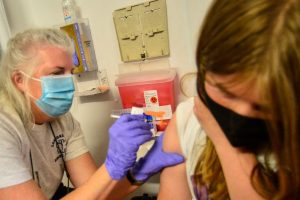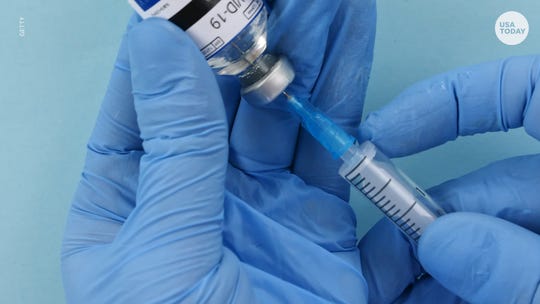Fact check: Peer-reviewed studies have shown safety, efficacy of COVID-19 vaccines

The claim: No peer-reviewed studies have demonstrated the safety and efficacy of the COVID-19 vaccines
In New Jersey, people who get vaccinated against COVID-19 in May can chase their shot with a free beer. West Virginia is handing out $100 savings bonds to young people who get vaccinated.
Perhaps the biggest prize of them all: Ohio is giving away $1 million to five lottery winners who have received the COVID-19 vaccine.
A post shared on social media, though, points out what it paints as an irony in the giveaways.
“Things not being offered to take the jab: peer-reviewed clinical studies proving its safety and efficacy,” claims a May 15 version of the post on Facebook after listing off the various vaccine incentives that have made headlines in recent weeks.
The post was shared more than 300 times. But it’s wrong.
Peer-reviewed data has shown the COVID-19 vaccine is safe and effective.
The New England Journal of Medicine published phase 3 clinical trial results for the Pfizer and Moderna two-dose regimens in December and February, respectively. In April, the journal published phase 3 data for the single-dose Johnson & Johnson vaccine.
All three “were peer-reviewed by multiple experts,” said Julia Morin, a spokeswoman for the NEJM, in an email to USA TODAY. “All COVID-19 research articles are published on an accelerated schedule and have the same steps as other articles: peer and statistical review, scientific and manuscript editing.”
The account that shared the May 15 post on Facebook did not respond to a request for comment.
Efficacy of the vaccines
The U.S. Food and Drug Administration granted emergency use authorization for the Pfizer and Moderna vaccines in December and for the Johnson & Johnson shot in February.
The data so far has shown the shots to be effective, particularly at preventing the most severe cases.
In its clinical trial that studied more than 30,000 participants, the Moderna vaccine was shown to be 94% effective at preventing COVID-19. Pfizer’s shot was 95% effective in a trial that studied nearly 44,000 participants.
Those studies demonstrated the two-shot vaccines “are remarkably effective,” said Paul Sax, a professor of medicine at Harvard Medical School, in the NEJM’s frequently asked questions concerning the vaccine.
The results are holding up in real-world settings too, he wrote, including in a mass vaccination program in Israel and among nursing home residents.
“Sometimes data are so strong we don’t even have to do statistical analysis – that’s what happened with both of these clinical trials,” he wrote in answer to frequently asked questions for the journal. “The results were that good.”
Johnson & Johnson’s single-dose vaccine was more than 66% effective at reducing moderate to severe COVID-19, and it reduced the risk of severe disease by 85%, a study published in April showed. More than 39,000 participants were included in the study. The efficiency for that vaccine was lower in part because the trial took place during a time when COVID-19 cases across the U.S. were much higher than during the Pfizer and Moderna trials. So participants had a far higher chance of being exposed as they went about their daily lives.
The Johnson & Johnson vaccine was at its most effective in reducing hospitalization. Two weeks after injection, the vaccine was 93% effective at preventing COVID-19 cases so severe that they required hospitalization, the study showed. Four weeks after administration, it was 100% effective in the study group.
Those three trials were the “touchstone” studies performed on the three vaccines approve for emergency use in the U.S., Rachel Graham, assistant professor of epidemiology at the University of North Carolina Chapel Hill’s School of Global Public Health, told USA TODAY.
Laurie Gayda, a vaccinator with Rescue Inc., gives Lola McGinnis, 12, of Bellows Falls, Vt., the first dose of the Pfizer COVID-19 vaccine as her sister, Lola, 12, waits for her shot on Monday, May 24, 2021. Rescue Inc. hosted a dual COVID-19 vaccine clinic at the Bellows Falls Fire Department, in Bellows Falls, Vt. People could get a scheduled dose of the Pfizer vaccine or go to the walk-in Johnson & Johnson clinic. (Kristopher Radder/The Brattleboro Reformer via AP) (Photo: Kristopher Radder, AP)
Safety of the vaccines
The clinical trials for the three vaccines approved for use in the U.S. drew similar conclusions about their safety: side effects were mild to moderate and resolved within a few days. Side effects included pain at the injection site, headache, fatigue and nausea, among others.
Injections of the Johnson & Johnson vaccine stopped briefly in April to investigate whether it was causing blood clots. The clots occurred mostly among adult women younger than 50 years old, according to the CDC.
The CDC and FDA investigated the cases of blood clots in unusual locations, such as the brain and abdomen, and low platelet levels, during an 11-day pause on using the vaccine. In resuming use of the vaccine, the agency said the benefits of the vaccine outweighed the risks.
As of May 18, the CDC had identified 30 people who received the vaccine and later developed clotting problems out of more than 9.6 million doses of the vaccine.
As of May 17, more than 273 million doses of all COVID-19 vaccines were administered in the U.S., according to the CDC.
A CDC system for the public to report adverse reactions to vaccines had received about 4,700 unconfirmed reports of deaths after receiving the COVID-19 vaccine at that time, or about 0.0017%. The CDC cautions, though, that a report to the Vaccine Adverse Effect Reporting System “does not mean that the vaccine caused the adverse event, only that the adverse event occurred some time after the vaccination.”
Fact check: CDC data on adverse effects of vaccine cannot determine cause
“A review of available clinical information, including death certificates, autopsy, and medical records has not established a causal link to COVID-19 vaccines,” according to the CDC.
Sax pointed out that all seven COVID-19-related deaths in the J&J trial were among the placebo group.
Long-term side effects “are extremely unlikely,” according to the CDC, because historically vaccine monitoring has shown side effects to appear within six weeks.
“Millions of people have received COVID-19 vaccines, and no long-term side effects have been detected,” according to the CDC’s website.
Moderna says its COVID vaccine is 100% effective in children 12 to 15 years old after the second dose. (Photo: Getty)
Peer review
A search on the National Library of Medicine’s online tool returns more than 1,000 results for research on the COVID-19 vaccines. However, all of those are not peer-reviewed because some of them are pre-prints.
Because the vaccines have been produced in real-time during the pandemic, more research results have been released as “pre-print” before peer review, Graham said. But experts have analyzed studies after their release.
“There was still peer review. There was very stringent peer review on all of these vaccines,” UNC’s Graham said. “No corners were cut in the context of the clinical trials.”
While the vaccines were quick to market, Graham said they were the product of years of pre-clinical research.
“These things did not come out of nowhere,” she said.
A dose of the Moderna COVID-19 vaccine awaits being injected into a patient’s arm in New Orleans on Saturday, April 17, 2021. (Photo: Edmund Fountain for USA TODAY)
Our ruling: False
The claim that peer-reviewed studies have not demonstrated the safety and efficacy of the COVID-19 vaccine is FALSE. Clinical trials that analyzed safety and efficacy for all three vaccines approved for use in the U.S. were peer-reviewed.
Our fact-check sources:
- New Jersey COVID-19 Information Hub, accessed May 25, What is the New Jersey “Shot and a Beer” program? What breweries are participating?
- The Washington Post, April 27, West Virginia is offering an incentive to get vaccinated: Money
- The Cincinnati Enquirer, May 24, More than 2.7 million sign up for Ohio’s first Vax-a-Million drawing
- University of Minnesota Center for Infections Disease Research and Policy, Jan. 4, Peer-reviewed data show high protection for leading COVID vaccines
- New England Journal of Medicine, Dec. 31, 2020, Safety and Efficacy of the BNT162b2 mRNA Covid-19 Vaccine
- New England Journal of Medicine, Feb. 4, Efficacy and Safety of the mRNA-1273 SARS-CoV-2 Vaccine
- New England Journal of Medicine, April 21, Safety and Efficacy of Single-Dose Ad26.COV2.S Vaccine against Covid-19
- New England Journal of Medicine, accessed May 25, Covid-19 Vaccine — Frequently Asked Questions
- New England Journal of Medicine, April 15, BNT162b2 mRNA Covid-19 Vaccine in a Nationwide Mass Vaccination Setting
- Centers for Disease Control and Prevention, March 19, Effectiveness of the Pfizer-BioNTech COVID-19 Vaccine Among Residents of Two Skilled Nursing Facilities Experiencing COVID-19 Outbreaks — Connecticut, December 2020–February 2021
- USA TODAY, April 23, Pause on Johnson & Johnson COVID vaccine in US lifted by FDA, use to resume
- Centers for Disease Control and Prevention, accessed May 25, Selected Adverse Events Reported after COVID-19 Vaccination
- Centers for Disease Control and Prevention, accessed May 25, Vaccine Adverse Event Reporting System (VAERS)
- Centers for Disease Control and Prevention, accessed May 25, Safety of COVID-19 Vaccines
- Rachel Graham, assistant professor of epidemiology at the University of North Carolina Chapel Hill, May 25, phone interview with USA TODAY
- NEJM Journal Watch, accessed May 28, Paul Sax biography
Thank you for supporting our journalism. You can subscribe to our print edition, ad-free app or electronic newspaper replica here.
Our fact check work is supported in part by a grant from Facebook.
Source: Read Full Article


